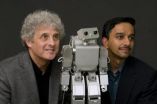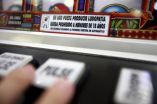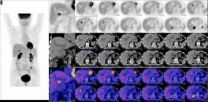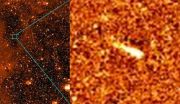(Press-News.org) Size matters when it comes to the nucleus of a cell, and now scientists have discovered the signals that control how big the nucleus gets.
Nuclear size varies not only among different species, but also in different types of cells in the same species and at different times during development. In addition, cancer cells are known to develop larger nuclei as they become more malignant. Screening for cervical cancer, for example, involves looking for grossly distorted nuclei in cervical cells collected during a Pap smear.
"Pathologists look at nuclear size in cancer cells for staging different cancers, but nobody knows what is behind this," said Rebecca Heald, professor of molecular and cell biology at the University of California, Berkeley.
As a result, she and post-doctoral fellow Daniel L. Levy explored why the nuclei of two species of African clawed frog are so different in size and discovered that the large nucleus of Xenopus laevis sucks in more material while growing than does the small nucleus of Xenopus tropicalis.
The two researchers tracked down the proteins streaming into the nucleus and discovered that they were importing structural material used to build the web of lamin proteins that shores up the inside of the nuclear shell. The faster the import of lamin and other structural proteins, the faster it is added to the underside of the nuclear envelope, inflating it like a balloon.
In addition, they found that another protein sits like a plug at the entrances to the nuclear envelope – the nuclear pore complexes – to slow the importation of large proteins. Together, these two different proteins – the importing protein, importin-alpha, and the gatekeeper, ntf2 – account for the difference in size between the nuclei of the two frogs.
"The different levels of these two factors is sufficient to account for our nuclear size differences," Levy said.
"There was a lot more importin-alpha and a lot less ntf2 in Xenopus laevis, and we found out that we can convert Xenopus tropicalis into laevis just by adding excess importin and partially getting rid of ntf2 in egg extracts," Heald said. "We thought this could be really complicated, but it isn't.
"Now that we understand some of the mechanisms that regulate nuclear size, we can try to decrease nuclear size in cancer cells ands ask, does the cancer cell care? Maybe it will and maybe it won't."
Levy and Heald report their findings in the Oct. 15 issue of the journal Cell.
Heald has long been interested in what regulates the size of a cell's internal structures – in particular, the nucleus and the spindles that pull chromosomes apart during cell division.
In certain amphibians, the larger the animal, the larger the genome and the larger the cells and nuclei. For mammals, however, that is not necessarily the case. Nevertheless, when mammalian cells become aneuploid – that is, they no longer have two copies of each chromosome – they often grow a larger nucleus. Aneuploidy is associated with cancer.
In 2006, Heald was awarded a five-year, $2.5 million Pioneer Award from the National Institutes of Health to pursue research on cell organelle size, work deemed too "risky" for regular NIH funding.
To explore these questions, she works in test tubes filled with the guts of hundreds of frog eggs. The guts consist of cell-free cytoplasm extracted from the cellular envelopes by centrifuging. By adding new proteins or antibodies that block existing proteins, she can explore the regulation of many activities inside the cell.
For these experiments, she and Levy extended the technique from X. laevis to the smaller X. tropicalis, whose eggs have about one-fifth the volume. Part of the size difference is due to the fact that X. laevis is tetraploid – it has four copies of nearly every chromosome – whereas X. tropicalis is diploid, with two copies of each chromosome. Working with extracts allowed the researchers to find importation proteins that differed in concentration between the two species and thereby track down the mechanism of nuclear inflation.
Specifically, X. laevis has three times more importin-alpha than does X. tropicalis, while tropicalis has four times more ntf2 than does laevis. By adjusting levels of these proteins in X. tropicalis egg extracts, they were able to make this species' nuclei balloon up to the size of X. laevis nuclei.
"We can now ask physiologically what happens when you change nuclear size," Heald said. "If you make the nucleus bigger, does it become more cancer-like? How related are these two phenomena, cancer and nuclear size, which are associated but with no real causal effect."
Heald and her colleagues are also tracking down the proteins that control the size of the spindles in X. laevis and X. tropicalis. Malfunctioning of spindles can lead to improper segregation of chromosomes during cell duplication, which results in aneuploidy and cancer.
INFORMATION:
Scientists find signals that make cell nucleus blow up like a balloon
Proteins that import structural material and that regulate the import determine cell size
2010-10-15
ELSE PRESS RELEASES FROM THIS DATE:
New research results change the understanding of atmospheric aerosol properties and climate effects
2010-10-15
Atmospheric fine particles affect the Earth's radiation balance by interacting with solar radiation and by participating in cloud formation. Biogenic volatile organic compounds are key players in new particle formation processes. Hence, terrestrial vegetation has an important role as the newly formed particles cool our climate. The chemical composition of such secondary organic aerosol (SOA) particles formed from volatile compounds emitted by vegetation is very complicated and only limited information on the phase state of SOA particles has been available. Thus the scientific ...
A reinvention of agriculture is needed to meet global challenges
2010-10-15
Des Moines, Iowa USA: World renowned scientists speaking at the World Food Prize Borlaug Dialogue have called for a radical transformation in the agriculture sector to cope with climate change, food security and to transition towards sustainability.
Dr Dennis Garrity, Director General of the World Agroforestry Centre and Professor MS Swaminathan, 1987 World Food Prize Laureate and founder of the MS Swaminathan Research Foundation, have teamed up to promote what they call a 'fresh out of the box solution' which is already dramatically improving crop yields while storing ...
I want to see what you see: Babies treat 'social robots' as sentient beings
2010-10-15
Babies are curious about nearly everything, and they're especially interested in what their adult companions are doing. Touch your tummy, they'll touch their own tummies. Wave your hands in the air, they'll wave their own hands. Turn your head to look at a toy, they'll follow your eyes to see what's so exciting.
Curiosity drives their learning. At 18 months old, babies are intensely curious about what makes humans tick. A team of University of Washington researchers is studying how infants tell which entities are "psychological agents" that can think and feel.
Research ...
Key to blood-brain barrier opens way for treating Alzheimer's and stroke
2010-10-15
While the blood-brain barrier (BBB) protects the brain from harmful chemicals occurring naturally in the blood, it also obstructs the transport of drugs to the brain. In an article in Nature scientists at the Swedish medical university Karolinska Institutet now present a potential solution to the problem. The key to the BBB is a cell-type in the blood vessel walls called pericytes, and the researchers hope that their findings will one day contribute to new therapies for diseases like Alzheimer's and stroke.
"Our new results show that the blood-brain barrier is regulated ...
Overseas nurses feel their skills are underused and they aren't valued or respected
2010-10-15
Many overseas nurses have negative experiences of living and working in the UK, particularly when it comes to feeling personally valued and professionally respected, according to the October issue of the Journal of Clinical Nursing.
Researchers from the University of Northampton also found that discrimination and racism still exist in the National Health Service and that the reality of first-world UK nursing is often very different to what overseas nurses expect.
Senior lecturer and nurse Julia Nichols and Professor of Neurophysiology Jackie Campbell carried out ...
Scientists perfect new nanowire technique
2010-10-15
Scientists at the University of Leeds have perfected a new technique that allows them to make molecular nanowires out of thin strips of ring-shaped molecules known as discotic liquid crystals (DLCs).
The findings could be an important step in the development of next generation electronic devices, such as light-harvesting cells and low-cost biosensors that could be used to test water quality in developing countries.
DLCs are disk-shaped molecules that are one of the more promising candidates for organic electronic devices. However, controlling their alignment has proved ...
4 kinds of compulsive gamblers identified
2010-10-15
Disorganised and emotionally unstable, poorly adapted, suffering from alcohol problems, impulsive, or with a "globally adapted" personality. These are the features of the four diagnosed types of compulsive gamblers identified by researchers at the University Hospital of Bellvitge (IDIBELL) and the Autonomous University of Barcelona (UAB). According to the scientific team, only one of these four shows signs of a significant pathology.
"We need to use different treatments for each sub-group of pathological gamblers in order to respond to their specific therapeutic difficulties ...
New malware could steal users social media behavior and info -- Ben-Gurion U. researchers
2010-10-15
BEER-SHEVA, ISRAEL, October 14, 2010 -- A new study by Ben-Gurion University of the Negev (BGU) researchers predicts that a new generation of malware (software written for malicious purposes like identity theft) could steal data on human behavior patterns, which is more dangerous than traditional, detectable attacks.
In the newly published paper, "Stealing Reality," Dr. Yaniv Altschuler and Dr. Yuval Elovici from BGU discuss malware threats that extract personal information about relationships in a real-world social network, as well as characteristic information about ...
New method is found for accurate diagnosis of gall bladder cancer, 1 of the most deadly
2010-10-15
Researchers a the University of Granada and the Department of Nuclear Medicine, Hospital Virgen de las Nieves at Granada found that the metabolic imaging diagnosis technique –based on the analysis of a structural analog of glucose labeled with a positron-emitting compound (18F)– allows early diagnosis of gall bladder cancer, a relatively rare disease with high mortality rates among most patients suffering from it.
For the purpose of this study, 62 patients were subjected to this scanning method, which represents the largest sample of patients with gall bladder cancer ...
Asteroid collision forensics
2010-10-15
In the first half of February 2009, two asteroids collided in a region of space beyond the orbit of Mars, as scientists from the Max Planck Institute for Solar System Research (MPS) in Germany have now discovered. The researchers were able to pinpoint the exact date of the impact more precisely than ever before. The debris of the crash had attracted the attention of scientists worldwide. Together with the largest earthbound telescopes and the Hubble Space Telescope, the OSIRIS camera system onboard ESA's space probe Rosetta, that was developed and is now operated under ...
LAST 30 PRESS RELEASES:
Heart disease, stroke deaths down, yet still kill more in US than any other cause
Light switches made of ultra-thin semiconductor layers
Creative talent: has AI knocked humans out?
Sculpting complex, 3D nanostructures with a focused ion beam
A year after undermining Bredt’s rule, UCLA scientists have made cage-shaped, double-bonded molecules that defy expectations
Human activities drive global dryland greening
PeroCycle announces new appointments as it builds a world-class board for meaningful climate impact
Magnetic avalanches power solar flares
LeapSpace goes live: the Research-Grade AI-Assisted Workspace built on trusted science
DNA tests reveal mysterious beluga family trees
Strategic sex: Alaska’s beluga whales swap mates for long-term survival
How early cell membranes may have shaped the origins of life
Cannabis legalization is driving increases in marijuana use among U.S. adults with historically lower consumption rates
Multifunctional dipoles enabling enhanced ionic and electronic transport for high‑energy batteries
Triboelectric nanogenerators for future space missions
Advancing energy development with MBene: Chemical mechanism, AI, and applications in energy storage and harvesting
Heteroatom‑coordinated Fe–N4 catalysts for enhanced oxygen reduction in alkaline seawater zinc‑air batteries
Meta-device for precision lateral displacement sensing
Plasma-guided mitotane for the treatment of adrenocortical carcinoma: adjuvant care to advanced disease
Theoretical study of laser-enhanced nuclear fusion reactions
Social environment impacts sleep quality
Optimized kinetic pathways of active hydrogen generation at Cu2O/Cu heterojunction interfaces to enhance nitrate electroreduction to ammonia
New design playbook could unlock next generation high energy lithium ion batteries
Drones reveal how feral horse units keep boundaries
New AI tool removes bottleneck in animal movement analysis
Bubble netting knowledge spread by immigrant humpback whales
Discovery of bats remarkable navigation strategy revealed in new study
Urban tributaries identified as major sources of plastic chemical pollution in the Yangtze River
UK glaucoma cases higher than expected and projected to reach 1.6 million+ by 2060
Type 2 diabetes prevention could more than halve carbon footprint linked to disease complications
[Press-News.org] Scientists find signals that make cell nucleus blow up like a balloonProteins that import structural material and that regulate the import determine cell size




